Going digital: Safe and efficient development of plastic components
Bosch Research Blog | Post by Jan-Martin Kaiser, 2021-12-17
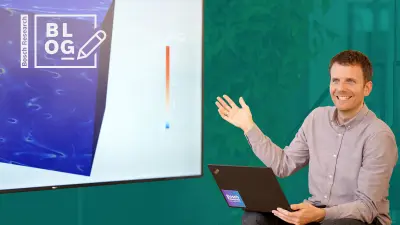
What do a 1-liter milk pack and a modern bike frame have in common?
They both weigh about 1 kg. And here the similarities end. Back in around 1820, the weight of the precursor of a modern bike was around 22 kg. Today, you can buy bikes weighing well below 10 kg and with frames lighter than 0.7 kg for a reasonable price. How is that possible?
The solution is a combination of new “magic materials” on the one hand, and new high-tech time and cost-saving development tools on the other. The materials are so-called continuous carbon fiber reinforced plastics. And the method involves simulation-based virtual testing and optimization tools.
The material design …
Continuous fiber reinforced plastics enable a demand-specific component design. Basically, the designer can define the component stiffness and strength in a specific region by placing ply of fibers in a predefined way. By doing so, he/she defines an optimized local material microstructure accordingly. However, to identify the optimum e.g., between strength and light weight, this requires numerous physical experiments on hardware prototypes, and hence is time and cost intensive.
The development method …
The second part of the solution is a multi-scale simulation approach. Such an approach is schematically shown in figure 1 and it seeks to simulate continuum-scale behavior on the component level by utilizing information from finer scales. In our example, on the micro scale the fiber orientation and diameter, as well as the mechanical properties of fiber and matrix are relevant. Having this information by hand due to material characterization tests or data bases, it can then be used in the upper scale to describe virtually the composite behavior in corresponding material models and enables finally a virtual component testing.
The combination of these two elements contributes to a cost efficient, virtual engineering with reduced physical testing time and effort and enables such outstanding achievements. The results are ultralight bike frames for reasonable prices today.
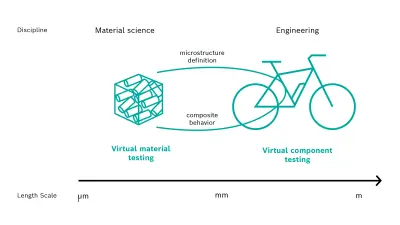
How does this relate to Bosch products?
Within Bosch, fiber reinforced materials are applied in numerous applications like gear wheels, housings, and connectors. Due to the required lot numbers, instead of continuous carbon fibers, short glass fiber reinforced thermoplastics are commonly used. They are processed fully automated in injection molding processes. None the less, from the engineering point of view, the previously described design approach in fully applicable.
In industrialized product development processes, the application of simulation software is standardly used and many design decisions and iterations are based on corresponding simulation results today. However, when it comes to short fiber reinforced thermoplastic components, the predictiveness of simulations is still limited. The underlying microstructure, which is induced by the production process, highly influences the material stiffness and strength, and thus strongly effects a component’s performance. In today’s standard simulations the microstructure is often neglected, or rough assumptions are made and hence, the trustworthiness of the simulation results is insufficient.
“When it comes to short fiber reinforced thermoplastic components, the predictiveness of simulations is still limited. The key solution: a holistic virtual product engineering approach.“
This is especially relevant, when considering safety-relevant components and crucial performance requirements. In such cases, costly and time-consuming mechanical hardware tests are carried out on a regular basis to gain more confidence. The aforementioned limitations result mainly from two categories of impact factors:
- Complex injection molding process induced material morphologies like fiber orientations and length distributions, crystallization and voids
- Complex environmental condition states like varying temperature and moisture and their impact on mechanical material properties
In the end, both categories of factors lead to highly complex component deformation, damage and failure behavior.
By focusing on the first challenge, two questions come up: Can we not improve the situation? Can we not provide tools and methods to drive forward a holistic virtual product engineering for injection molded thermoplastic components within Bosch?
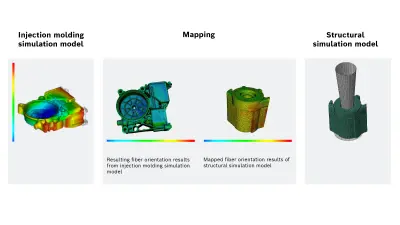
The key solution is the concept of multi-scale material modeling.
This concept emerged over the last few decades and seeks to simulate continuum-scale behavior on a specimen or component level by utilizing information from finer scales rather than resorting to empirical constitutive models on the upper scale. The decision to pursue a multi-scale approach always involves a trade-off between increased model complexity and correspondingly increased accuracy. An appropriate guiding principle is given by Einstein’s quote: “Make everything as simple as possible, but not simpler”. In our case, it was clear that we had to explicitly consider process induced fiber orientation in a first step, since it has a major impact on the overall material deformation, damage and failure behavior.
Based on that decision, we developed and evaluated an integrative multi-scale simulation chain concept, as shown in Figure 2. This concept allows local fiber orientation from injection molding simulations to be considered in structural simulations and is now established. The increased model complexity (being predictive and reducing the uncertainties in material strength) leads, as a trade-off, to the need for additional time-consuming, costly material characterization tests on the specimen level for material model calibration. Besides specimen testing, this also includes ordering raw materials, producing test specimens with different microstructures by injection molding and analyzing the fiber orientation using computed tomography (Figure 3, Experimental).
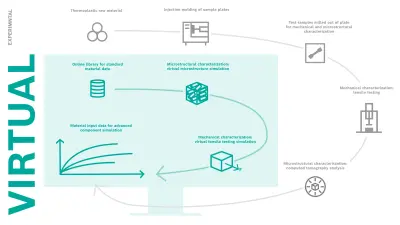
It is clear that the attractiveness of applying such multi-scale concepts in everyday work is significantly limited owing to this additional effort, especially in time-critical projects. This had to be changed and since in public databases like CAMPUS plastics thousands of standard data sets are currently available based on ISO527 test specimens, we started asking: Can we not use these public data in combination with our multi-scale concepts to generate high fidelity material input data synthetically instead of experimentally?
The idea of a virtual material testing lab was born
Instead of ordering raw materials, producing test specimens with different microstructures and testing and analyzing them according to our standards, we set up a virtual, multi-scale-based material testing concept. The concept is based on so-called Representative Volume Elements (RVE). A RVE is defined as the smallest volume over which a measurement can be made that will yield a representation of the entire volume, in our case the region of interest of our test specimen. By applying arbitrary loads under arbitrary orientations, RVE simulations can be used to synthetically generate desired material input data for our multi-scale modeling approach, whereas the input data from public databases are used as reference data (Figure 3, Virtual).
And what about the environmental condition states?
Temperature and moisture affect the polymer molecules. On that length scale, molecular dynamic (MD) simulations can be used for analyzing the physical movements of molecules. Currently, we are still evaluating the integration of MD simulations into our virtual material testing lab. This method offers the potential to directly simulate humidity and temperature dependent material modelling parameters which are not available in any public database today and hence would have to be experimentally analyzed when required as material input data. Of course, incorporating an MD simulation into our multi-scale concept, which basically means adding an additional, lower scale as shown in Figure 4, will further increase the overall complexity. We are looking forward to evaluating the new trade-offs and tackling the next challenges
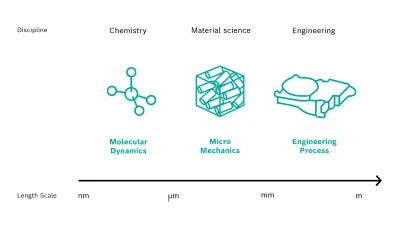
The approach presented is one key element within our plastics’ engineering strategy in the research portfolio “Modeling, Simulation, Optimization and New Materials” at Bosch Research. Our vision is to empower our customers - in engineering departments and development projects, at manufacturing sites or in neighboring portfolios – and to increase the pace by enabling holistic virtual material and component engineering, supported by advanced testing methods. And that is exactly what drives and motivates us - a team consisting of technicians and engineers - in our daily work.
We are looking forward to evaluating the new trade-offs and tackling the next challenges
Are you interested in our research work? Don’t hesitate to share your thoughts on the future of simulation in multi-scale modelling and virtual material and product engineering via our discussion page.
Profile

Author: Jan-Martin Kaiser
Jan-Martin is leading Bosch's research group focusing on the development and implementation of simulation methods for a holistic virtual reliability assessment of polymer components. He is passionate about advanced multi-scale and data-driven simulation methods as well as bringing them into industrial applications to significantly increase efficiency in product development.


